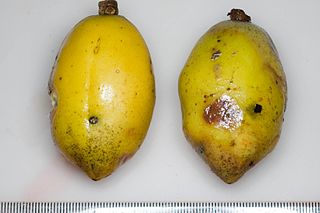
Glycydendron is a genus of plants, under the family Euphorbiaceae first described as a genus in 1922. It is native to South America.
- Glycydendron amazonicumDucke - French Guinea, Suriname, Guyana, Ecuador, Peru, Bolivia, northwestern Brazil, possibly Colombia
- Glycydendron espiritosantenseKuhlm, - State of Espirito Santo in Brazil

Mabea is a plant genus of the family Euphorbiaceae first described in 1775. It is native to Central and South America as well as Mexico and Trinidad.

Maprounea is a plant genus of the family Euphorbiaceae first named as a genus in 1775. It is native to tropical Africa, Trinidad, and tropical Central and South America.
- Maprounea africana - W + C + S Africa, from Benin to Zimbabwe
- Maprounea amazonica - Colombia, Venezuela, N Brazil
- Maprounea brasiliensis - Brazil, Paraguay, Bolivia
- Maprounea guianensis - Trinidad, Panama, Colombia, Venezuela, French Guiana, Suriname, Guyana, Brazil, Peru, Ecuador, Bolivia, Paraguay
- Maprounea membranacea - Nigeria, Cameroon, Gabon, Equatorial Guinea, Cabinda, Central African Republic, Congo, Zaire

Caryocar is a genus of flowering plants, in the South American family Caryocaraceae described as a genus by Linnaeus in 1771. It is native primarily to South America with a few species extending into Central America and the West Indies.
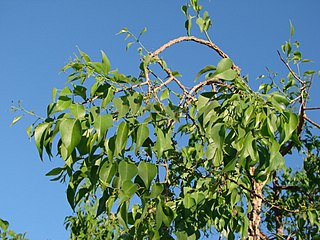
Agonandra is a genus of plants in the family Opiliaceae described as a genus in 1862.

Dracontium is a genus of flowering plants similar to those of Amorphophallus. Unlike Amorphophallus which is found in the Old World, this genus has a New World distribution and is native to South America, Central America, southern Mexico, and the West Indies.

Dicranopygium is a genus of plants belonging to the family Cyclanthaceae, first described as a genus in 1954. They are distributed in the Neotropical realm from southern Mexico to Peru.

Alseis is a genus of flowering plants in the family Rubiaceae. It was described by Heinrich Wilhelm Schott in 1827. The genus is native to tropical Latin America from southern Mexico to Brazil.
Forsteronia is a genus of plants in the family Apocynaceae, first described as a genus in 1818. It is native to South America, Central America, Mexico, and the West Indies.
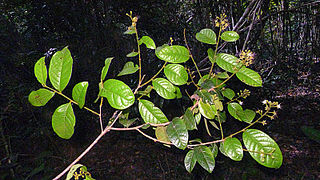
Hirtella is a genus of 110 species of woody trees in family Chrysobalanaceae. It was first described as a genus by Linnaeus in 1753. Hirtella naturally occurs in tropical forests throughout Latin America, the West Indies, southeast Africa, and Madagascar. The flowers are mainly pollinated by butterflies.

Renealmia is a plant genus in the family Zingiberaceae. Its members are native to tropical Africa and tropical America. In Peru, fruits and tubers are sources of indigenous dyes. and indigenous medical treatments for leishmania and malaria In Colombia, it is used to treat snakebite. Bracts and leaves can serve as phytotelmata, retaining small quantities of water that offer habitat for other organisms.

Rhodospatha is a genus of plant in family Araceae. It is native to South America, Central America, and southern Mexico.
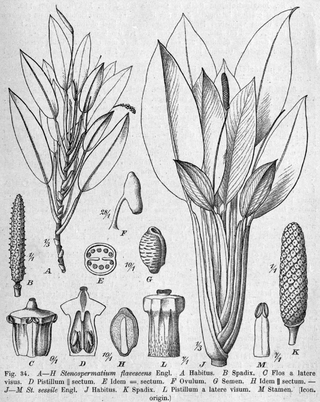
Stenospermation is a genus of plant in family Araceae native to South America and Central America.

Bixa is a genus of plants in the family Bixaceae. It is native to Mexico, Central America, Caribbean, and South America, and naturalized in other places.

Ischnosiphon is a genus of plants native to Central America, South America, Trinidad and the Lesser Antilles. It was first described as a genus in 1859.
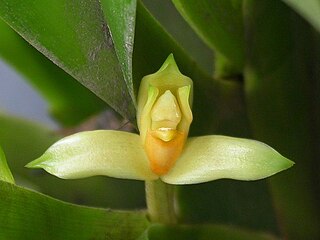
Heterotaxis is a genus of orchids native to Latin America from central Mexico to Bolivia, and also to parts of the West Indies. One species extends into Florida.
- Heterotaxis brasiliensis(Brieger & Illg) F.Barros - Brazil
- Heterotaxis discolor(Lodd. ex Lindl.) Ojeda & Carnevali - Belize, Nicaragua, Venezuela, the Guianas, Bolivia, Brazil, Bolivia, Peru, Ecuador
- Heterotaxis equitans(Schltr.) Ojeda & Carnevali - Venezuela, Suriname, Guyana, Bolivia, Brazil, Bolivia, Peru, Ecuador
- Heterotaxis fritziiOjeda & Carnevali - Ecuador
- Heterotaxis maleolens(Schltr.) Ojeda & Carnevali - Chiapas, Central America
- Heterotaxis microiridifolia(D.E.Benn. & Christenson) Ojeda & Carnevali - Peru
- Heterotaxis santanae(Carnevali & I.Ramírez) Ojeda & Carnevali - Brazil, Ecuador, Venezuela
- Heterotaxis schultesiiOjeda & G.A.Romero - Brazil, Colombia
- Heterotaxis sessilis(Sw.) F.Barros - widespread from Veracruz and Florida south to Brazil
- Heterotaxis superflua(Rchb.f.) F.Barros - Brazil, Venezuela, the Guianas, Bolivia, Ecuador, Peru
- Heterotaxis valenzuelana(A.Rich.) Ojeda & Carnevali - Central America, Cuba, Venezuela, Colombia, Ecuador, Brazil
- Heterotaxis villosa(Barb.Rodr.) F.Barros - Brazil, Venezuela, the Guianas, Bolivia, Ecuador, Peru, Colombia
- Heterotaxis violaceopunctata (Rchb.f.) F.Barros - Brazil, Venezuela, the Guianas, Ecuador, Peru, Colombia

Lacmellea is a genus of flowering plants in the family Apocynaceae first described as a genus in 1857. It is native to South America and Central America.
- Lacmellea abbreviataJ.F.Morales - Colombia
- Lacmellea aculeata(Ducke) Monach - Peru, NW Brazil, the Guianas
- Lacmellea arborescens(Müll.Arg.) Markgr. - Brazil, Bolivia
- Lacmellea bahiensisJ.F.Morales - Bahia
- Lacmellea costanensisSteyerm. - N Venezuela
- Lacmellea densifoliata(Ducke) Markgr. - Pará
- Lacmellea edulisH.Karst. - Panama, Venezuela, Colombia, Ecuador, Peru, Brazil
- Lacmellea floribunda(Poepp.) Benth. & Hook.f. - Peru, NW Brazil, Suriname, French Guiana
- Lacmellea foxii(Stapf) Markgr. - Peru
- Lacmellea gracilis(Müll.Arg.) Markgr. - N Peru, NW Brazil
- Lacmellea guyanensis(Müll.Arg.) Monach - French Guiana
- Lacmellea klugiiMonach. - Peru
- Lacmellea macranthaJ.F.Morales - Ecuador
- Lacmellea microcarpa(Müll.Arg.) Markgr. - Colombia, S Venezuela, NW Brazil
- Lacmellea oblongataMarkgr. - SE Colombia, Ecuador, Peru
- Lacmellea panamensis(Woodson) Markgr. - Costa Rica, Panama, Colombia, Ecuador
- Lacmellea pauciflora(Kuhlm.) Markgr. - Brazil
- Lacmellea peruviana(Van Heurck & Müll.Arg.) Markgr. - Peru
- Lacmellea pygmaeaMonach. - Amazonas State in Venezuela
- Lacmellea ramosissima(Müll.Arg.) Markgr. - Colombia, S Venezuela, NW Brazil
- Lacmellea speciosaWoodson - Costa Rica, Panama, Colombia, Ecuador, Peru
- Lacmellea standleyi(Woodson) Monach. - Belize, Guatemala, Honduras
- Lacmellea utilis(Arn.) Markgr. - S Venezuela, Guyana
- Lacmellea zamoraeJ.F.Morales - Costa Rica
Tassadia is a genus of plants in the family Apocynaceae, first described as a genus in 1844. It is native primarily to South America, with one species extending north into Central America, S Mexico, and Trinidad.
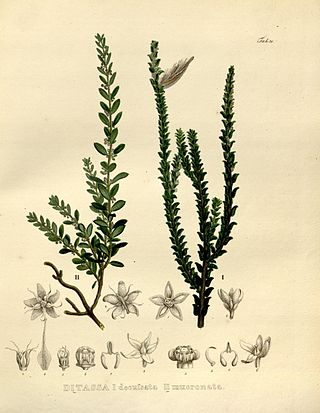
Ditassa is a genus of plant in the family Apocynaceae, first described as a genus in 1810. It is native to South America.
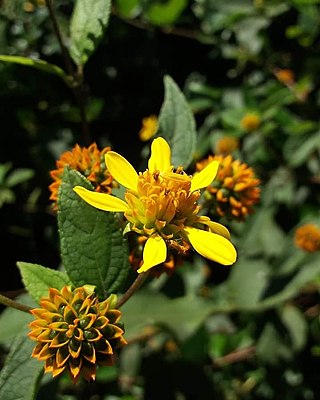
Tilesia is a genus of flowering plants in the family Asteraceae. Species in the genus Tilesia are found in Cuba and South America.


















